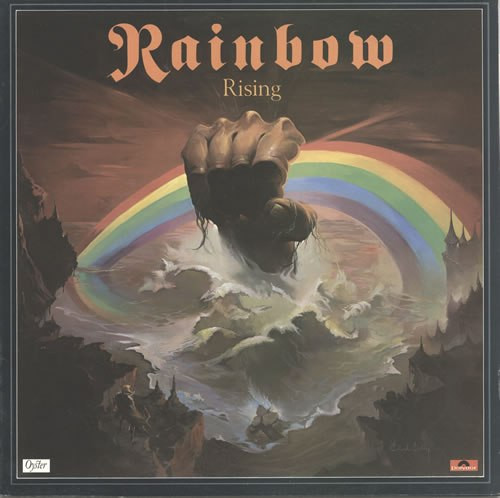„Tarot Woman“ is the opening track of Rainbow’s 1976 album Rising, a landmark release in the evolution of heavy metal and power metal. Featuring the legendary Ritchie Blackmore (guitar) and Ronnie James Dio (vocals), the song sets the stage for the album’s mystical, fantasy-driven themes.
The lyrics of „Tarot Woman“ tell the story of a mysterious, supernatural woman with the power to foresee fate, guide destinies, or possibly deceive those who seek her wisdom. The song’s narrative plays on themes of prophecy, destiny, and the dangers of placing one’s trust in forces beyond comprehension.
Musically, the track opens with an extended synthesizer intro, unusual for Rainbow at the time, before launching into a driving, galloping rhythm and Blackmore’s signature neoclassical guitar work. Dio’s powerful, storytelling vocals add depth to the mystical atmosphere, making this one of Rainbow’s most iconic songs.
Overview
At its core, „Tarot Woman“ explores:
- A protagonist who seeks guidance from a fortune teller but is confronted with an uncertain or ominous fate.
- Themes of prophecy, destiny, and the supernatural, emphasizing both fascination and fear.
- The idea of being drawn into something powerful yet potentially dangerous—perhaps fate itself.
- A fusion of storytelling and vivid, mystical imagery, reinforced by Dio’s commanding delivery.
Narrative Structure & Themes
1. The Allure of the Mystic (Opening Verse & Setting the Stage)
- The song immediately establishes a sense of mysticism and curiosity:
“I don’t know what I’m gonna do, I see my eyes are turning blue”
- The uncertainty and transformation in the protagonist hints that he is already being affected by the Tarot Woman’s power.
- „Eyes turning blue“ could symbolize a spiritual awakening or an unsettling change, brought on by a glimpse into his own fate.
- Themes: Mystery, supernatural influence, personal transformation.
2. The Encounter with the Tarot Woman (Prophecy & Temptation)
- As the protagonist meets the Tarot Woman, her power becomes clear:
“She looks at me and then she smiles / Says come with me, you’re the chosen one”
- The Tarot Woman is seductive yet authoritative—she holds the key to some great knowledge.
- Calling him “the chosen one” adds an element of fate or a predestined journey.
- Themes: Destiny, manipulation, prophecy.
3. The Fear & Uncertainty of Fate (Ominous Realization & Suspicion)
- As the reading or vision unfolds, the protagonist starts to feel uneasy:
“She lays a card down on the table, the candle flickers and the shadows dance”
- The imagery of flickering light and moving shadows suggests an eerie, possibly deceptive atmosphere—is the Tarot Woman guiding him, or is she a force of doom?
- The card itself is not revealed, leaving his fate unknown.
- Themes: Fear of the unknown, fate as a double-edged sword, mystical deception.
- The protagonist now seems trapped:
“I feel the magic running through my brain”
- This suggests he has been altered by the experience—the Tarot Woman’s influence is permanent.
- Themes: The power of prophecy, irreversible destiny, losing control.
4. The Journey Begins (Final Realization & Uncertain Future)
- The song ends without resolution—the protagonist has received his fate, but what it means is unclear:
“I don’t know what I’m gonna do”
- The repetition of this line reinforces that, despite seeking answers, he is now more lost than ever.
- The Tarot Woman has set him on a path he cannot escape, whether it leads to glory or doom.
- Themes: The paradox of knowledge, fate vs. free will, the dangers of seeking answers beyond human understanding.
Themes & Symbolism
1. Fate & Prophecy
- The Tarot Woman represents both wisdom and danger—the power to see the future is not necessarily a gift but a burden.
- The protagonist sought answers, but now he is trapped in the uncertainty of fate.
- The song’s structure reinforces the idea that fate cannot be escaped, as it ends in ambiguity.
2. The Lure of the Supernatural
- The Tarot Woman is both alluring and ominous—she is a guide, but possibly a deceiver.
- This reflects a classic heavy metal theme of supernatural figures who tempt, manipulate, or enlighten (similar to later Dio songs like „Holy Diver“ and „Don’t Talk to Strangers“).
3. The Cost of Seeking Knowledge
- The protagonist wanted to see his future, but the experience leaves him disoriented and lost.
- This is reminiscent of classic myths where mortals attempt to see their destiny and end up doomed because of it.
Musical & Emotional Impact
1. The Hypnotic, Synth-Led Introduction
- The song opens with a mesmerizing synthesizer line, setting a mystical, dreamlike atmosphere.
- This introduction foreshadowed the increasing role of keyboards in heavy metal, later influencing bands like Iron Maiden, Stratovarius, and Yngwie Malmsteen’s Rising Force.
2. The Galloping Riff & Dio’s Vocal Power
- After the intro, the song kicks into high gear with a driving riff, mirroring the protagonist’s accelerating journey into the unknown.
- Dio’s commanding, dramatic vocals enhance the storytelling, making the listener feel the protagonist’s confusion and fascination.
3. The Ambiguous Ending
- Unlike many rock songs that build to a conclusion, „Tarot Woman“ leaves the story unresolved, reinforcing the feeling of uncertainty and fate being open-ended.
Legacy & Influence
- „Tarot Woman“ is considered one of the defining songs of early power metal and neoclassical metal.
- The song’s themes of prophecy, destiny, and mystical figures would be expanded upon in later Rainbow albums and heavily influenced Dio’s solo career.
- The keyboard-driven intro and dramatic storytelling inspired later metal acts, from Iron Maiden to Blind Guardian and Rhapsody of Fire.
Final Verdict
„Tarot Woman“ is a mystical, powerful, and enigmatic metal classic that blends fantasy storytelling with a hard-driving sound. Its cryptic lyrics and Dio’s commanding vocal delivery immerse the listener in a world of prophecy and uncertainty.
With haunting imagery, galloping rhythms, and an unresolved fate, the song captures the double-edged nature of seeking knowledge—sometimes, the more you learn, the less certain you become.
As the opening track of Rising, it sets the perfect tone for an album that would shape the future of metal.



